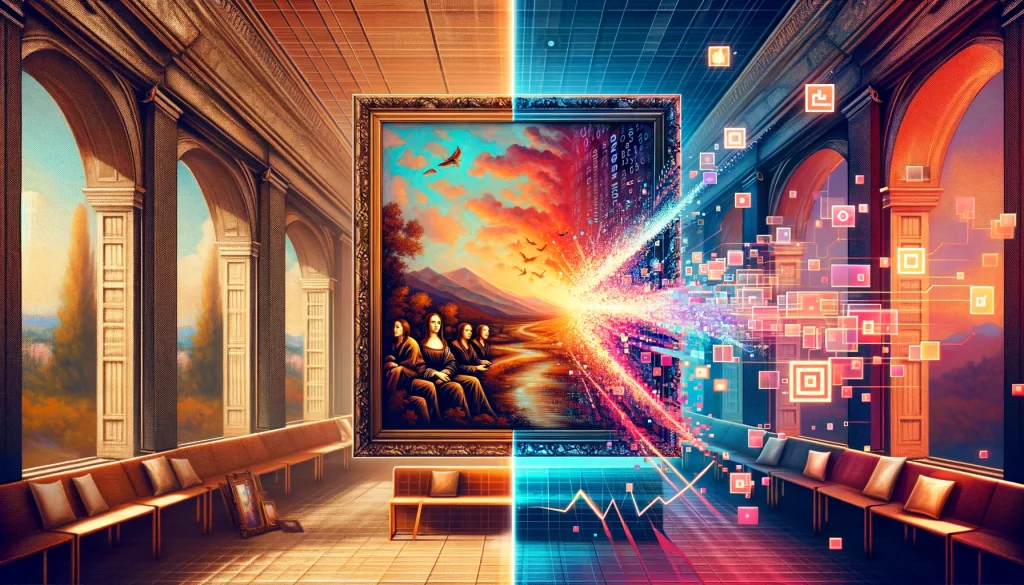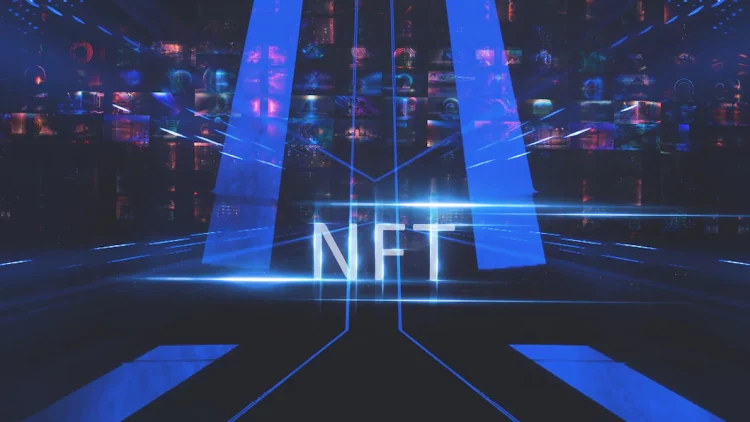Introduction
The advent of blockchain technology has transformed several industries, and the art market is no exception. Among the various blockchain applications, Non-Fungible Tokens (NFTs) have emerged as a game-changer in the art world. NFTs, which represent ownership of unique digital assets, have created a new way for artists to create, sell, and showcase their work while providing buyers with verified ownership of digital art.
Traditionally, the art market has been known for its exclusivity, high barriers to entry, and opaque pricing mechanisms. However, NFTs have introduced a disruptive force, providing opportunities for both established and emerging artists to reach global audiences, while also changing how art is valued, sold, and traded.
This article explores how NFTs are revolutionizing the art market by enhancing accessibility, establishing new forms of value, and creating unprecedented opportunities for creators, collectors, and investors alike.
1. The Rise of NFTs in the Art Market
NFTs are digital tokens stored on a blockchain that signify ownership or proof of authenticity for a particular asset, whether it’s an image, video, audio file, or even a tweet. Unlike cryptocurrencies such as Bitcoin or Ethereum, NFTs are unique, meaning each one has a distinct value and cannot be exchanged on a one-to-one basis.
The global art market, which has historically been dominated by galleries, auction houses, and traditional art dealers, is increasingly embracing NFTs as a new mode of exchange. In 2021, NFT art sales skyrocketed, with platforms such as OpenSea, Foundation, and Rarible facilitating millions of dollars in transactions. High-profile NFT sales, such as Beeple’s digital artwork “Everydays: The First 5000 Days,” which sold for $69 million at Christie’s, have brought unprecedented attention to the space.
1.1 The Impact on Traditional Art Market Structures
NFTs have disrupted traditional art market structures in several ways:
- Access to Artists: Previously, artists had limited opportunities to reach collectors, often relying on galleries or intermediaries. NFTs, however, allow artists to bypass these intermediaries and sell directly to collectors, democratizing access to the art market.
- Lower Entry Barriers: NFT platforms are relatively accessible to artists of all levels. The ability to mint and sell art as NFTs doesn’t require a gallery or auction house, making it easier for emerging artists to showcase their work globally.
- Global Audience: NFTs have made art accessible to a global audience of buyers and collectors. An artist’s work can be viewed, purchased, and resold across borders without the constraints of geographic location or physical space.
2. Redefining Ownership and Value in the Art Market
The concept of ownership has been radically redefined with the advent of NFTs. In traditional art markets, ownership is signified by possession of the physical artwork. However, in the NFT space, ownership is tied to the digital representation of the artwork, recorded on a blockchain.
2.1 Provenance and Authenticity
One of the most significant challenges in the art world has always been the issue of provenance — the history of ownership and authenticity of a work of art. Forged works and disputed ownership have plagued the market for centuries.
NFTs solve this problem by providing a transparent and immutable record of ownership. When an artist mints an NFT, the blockchain records this event, creating an irreversible, publicly visible ledger of the artwork’s provenance. Every subsequent transfer or sale of the NFT is also recorded, allowing potential buyers to verify authenticity and ownership at any point in time.
This verification process reduces the risk of fraud and increases confidence among buyers and collectors.
2.2 Programmable Art and Smart Contracts
Smart contracts, which are self-executing contracts with the terms of the agreement directly written into code, allow artists to program their NFTs with unique features that provide additional value.
For example, artists can encode royalty mechanisms into NFTs. Every time an NFT is resold, a percentage of the transaction price is sent to the artist, ensuring they continue to earn from the appreciation of their work in secondary markets. This concept is revolutionary in that it challenges the traditional art market model, where artists typically earn only once from the initial sale.
This provides an ongoing stream of income for artists and incentivizes the creation of high-quality, valuable works. Furthermore, artists can embed interactive or evolving elements in their NFTs, allowing buyers to engage with and even influence the work over time.

3. Creating New Revenue Streams for Artists
NFTs are not only changing how art is sold; they are creating new revenue streams for artists and content creators that didn’t exist in traditional markets.
3.1 Direct Monetization of Digital Art
Before NFTs, digital art was often seen as less valuable than physical artwork. Digital artists faced challenges in monetizing their work because of the ease with which it could be copied and shared. NFTs change that by turning digital art into a one-of-a-kind, verifiable asset that can be bought and sold just like physical artwork.
With NFTs, digital artists can now sell their creations directly to collectors in a secure and transparent manner. This opens up a wealth of opportunities for digital artists who were previously excluded from the traditional art market.
3.2 Fractional Ownership and Collective Investment
Another innovative concept enabled by NFTs is fractional ownership. By minting fractionalized NFTs, an artwork can be divided into shares, allowing multiple investors to own a portion of a high-value piece of art. This reduces the financial barrier to entry for collectors and enables smaller investors to participate in the ownership of valuable assets.
For instance, a $1 million NFT art piece could be divided into 1,000 fractionalized NFTs, each worth $1,000. These NFTs can then be traded independently, giving each investor the opportunity to sell their share without the need for the entire artwork to change hands.
This model creates a new way of investing in art, democratizing the market and providing liquidity to otherwise illiquid assets.
4. NFTs and the Evolution of Art as an Investment
NFTs are not just collectibles; they are rapidly becoming an asset class of their own. Art as an investment has long been associated with the ultra-wealthy, but NFTs are breaking down these barriers and enabling more people to view art as a viable investment vehicle.
4.1 NFT Art Investment Funds
In response to growing interest in NFTs, new investment funds have been created to pool capital for purchasing high-value NFT art. These funds operate in a similar way to traditional art investment funds, but they focus specifically on acquiring NFT-based art pieces. Investors in these funds can gain exposure to the growing NFT art market without having to individually purchase and manage digital assets.
4.2 Speculative Investment and NFT Market Trends
Just as with traditional art, NFTs are subject to speculative investment behaviors. The price of NFTs can fluctuate significantly based on market demand, the reputation of the artist, and broader trends in the NFT space. Some investors view NFTs as an alternative investment class with high growth potential, similar to how people have invested in rare or valuable physical art over the years.
5. The Environmental Impact of NFTs and Solutions
As the NFT market grows, environmental concerns have arisen due to the energy-intensive nature of blockchain networks, particularly Ethereum, on which most NFTs are minted. The environmental impact of NFTs has sparked debates about sustainability and the carbon footprint of digital art creation and trading.
However, several solutions are emerging to address these concerns:
- Transition to Proof of Stake: Ethereum, which currently uses Proof of Work (PoW) as its consensus mechanism, is transitioning to Proof of Stake (PoS), a more energy-efficient protocol. This shift will significantly reduce the environmental impact of NFTs minted on the Ethereum network.
- Eco-Friendly Blockchain Networks: Several eco-friendly blockchain networks, such as Flow and Tezos, have emerged as alternatives to Ethereum, providing a more sustainable platform for minting and trading NFTs.
- Carbon Offsetting Initiatives: Some NFT platforms and creators are taking proactive steps to offset the environmental impact of their work by investing in carbon credits or funding renewable energy projects.
6. The Future of NFTs in the Art Market
The future of NFTs in the art market appears incredibly promising. As blockchain technology and the NFT ecosystem continue to evolve, the ways in which art is bought, sold, and appreciated will continue to change. Artists, collectors, and investors are likely to see further innovations in:
- NFTs as Experiences: Future NFTs could offer interactive experiences, virtual reality galleries, and augmented reality features that enhance the connection between the artist and the collector.
- Integration with Physical Art: The blending of physical and digital art through NFTs is likely to become more prominent. For example, physical artwork could be sold alongside its digital NFT counterpart, creating a hybrid model of ownership.
- Expansion into New Creative Domains: NFTs will likely expand into more creative domains beyond digital art, including fashion, music, literature, and even virtual worlds.
Conclusion
NFTs are transforming the art market by offering artists, collectors, and investors a new way of engaging with art. From democratizing access to the art world and creating new revenue streams for creators, to providing a secure, transparent method of verifying ownership and authenticity, NFTs are reshaping the landscape of art sales and investment.
While challenges related to environmental sustainability and market volatility remain, the future of NFTs in the art market looks incredibly promising. As the technology continues to evolve and new solutions emerge, NFTs have the potential to unlock even more opportunities, bridging the gap between the digital and physical worlds, and making art more accessible, inclusive, and innovative than ever before.
NFTs are not just a passing trend; they represent a paradigm shift that is redefining the way we think about art, ownership, and value.

















































